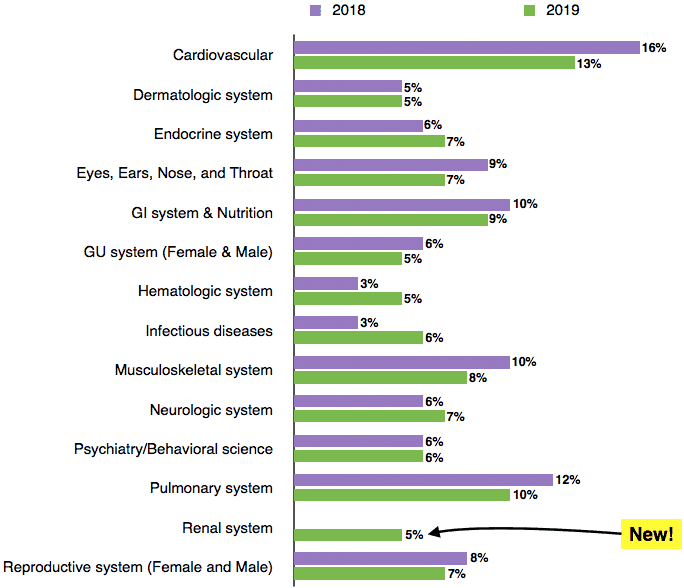New Update: 2019 NCCPA PANCE Content Blueprint & A Mock PANCE

The Rosh Review PANCE Qbank is updated to reflect the 2019 NCCPA PANCE Content Blueprint changes.
Back in March 2018, we posted this update. Let’s review the 2019 NCCPA PANCE Content Blueprint changes:
Summary of changes
Categories that INCREASED
- Endocrine system: Now 7% (was 6%)
- Hematologic system: Now 5% (was 3%)
- Infectious diseases: Now 6% (was 3%)
- Renal: Now 5% (was 0%) – new
Categories that DECREASED
- Cardiovascular: Now 13% (was 16%)
- Eyes, ears, nose, and throat: Now 7% (was 9%)
- GI section and nutrition: Now 9% (was 10%)
- GU system (female and male): Now 5% (was 6%)
- Musculoskeletal system: Now 8% (was 10%)
- Pulmonary system: Now 10% (was 12%)
- Reproductive system (female and male): Now 7% (was 8%)
Individual category updates
Cardiovascular
- Now 13% (was 16%). Decreased
- Removed subcategories:
- Other forms of heart disease was removed and the topics within this section, acute and subacute bacterial endocarditis, acute pericarditis, cardiac tamponade, and pericardial effusion were placed in a new subcategory Traumatic, infectious, and inflammatory heart conditions.
- Valvular disorders was streamlined
- Lipid disorders (previously included in the Endocrinology category) is now in the Cardiovascular category
- New subcategories
- Sinus arrhythmia
- Vasovagal hypotension
Dermatologic System
- Now 5% (was 5%). No Change
- New subcategories
- Envenomations and arthropod bite reactions
- Infectious disease
- Keratotic disorders
- Neoplasms
- Pigment disorders
- Skin integrity
- Vascular abnormalities
- New topics
- Folliculitis
- Hand foot and mouth disease
- Parasitic section
- Lacerations
- Stasis dermatitis
- Cherry angioma
- Pemphigus
- Telangiectasia
Endocrine System
- Now 7% (was 6%). Increased
- The neoplastic diseases section has been expanded with the addition of four new lessons.
- New subcategories
- Parathyroid disorders was a topic, now a subcategory
- Neoplasms
- Multiple endocrine neoplasia
- Neoplastic syndrome
- Primary endocrine malignancy
- Syndrome of inappropriate antidiuretic hormone secretion (SIADH)
- Removed subcategories
- Hypercholesterolemia
- Hypertriglyceridemia
Eyes, Ears, Nose, Throat
- Now 7% (was 9%). Decreased
- New topics in the Eye subcategory
- Conjunctival disorders
- Corneal disorders
- Infectious
- Keratitis
- Lacrimal disorders
- Lid disorders
- Neuro-ophthalmologic disorders
- Traumatic disorders
- Globe rupture
- Vascular disorders
- Vision abnormalities
- Amaurosis fugax
- Amblyopia
- Scleritis
- New structure to the Ear subcategory
- External ear
- Cerumen impaction
- Trauma
- Internal ear
- Middle disorders
- Hearing impairment
- Other abnormalities of the ear
- External ear
- Nose and Sinus disorders
- Trauma is a new topic
- New topics in Oropharyngeal disorders
- Infectious/inflammatory disorders
- Salivary disorders
- Trauma
- Other oropharyngeal disorders
- Deep neck infection
GI System and Nutrition
- Now 9% (was 10%). Decreased
- New subcategory: Metabolic disorders
- G6PD deficiency
- Paget disease
- Phenylketonuria
- Rickets
- New subcategory: Nutritional and vitamin disorders
- Hypervitaminosis and hypovitaminosis
- New subcategory: Food allergies and food sensitivities
- Gluten intolerance
- Lactose intolerance
- Nut allergies
- Abscess/fistula, anal fissure, fecal impaction, and hemorrhoids now part of subcategory Colorectal disorders
- New subcategory: Neoplasms
- Benign
- Malignant
- Subcategory removed: Rectum
Genitourinary (GU) System (Female and Male)
- Now 5% (was 6%). Decreased
- Subcategories removed: Renal (made into its own category)
- New subcategory: Bladder disorders
- Overactive bladder
- Bladder prolapse
- New subcategory: Congenital and acquired disorders
- Cryptorchidism
- Peyronie disease
- Trauma
- Vesicoureteral reflux.
- New subcategory: Human sexuality
- New subcategory: Neoplasms
- Bladder cancer
- Penile cancer
- Prostate cancer
- Testicular cancer
- New subcategory: Penile disorders
- Erectile dysfunction
- Hypospadias/epispadias
- Paraphimosis/phimosis
- New subcategory: Prostate disorders
- Benign prostatic hyperplasia
- New subcategory: Testicular disorders
- Hydrocele/varicocele
- New subcategory: Urethral disorders
Hematologic System
- Now 5% (was 3%). Increased
- New subcategories:
- Autoimmune disorders
- Cytopenias
- Anemia
- Leukopenia
- Cytoses
- Polycythemia
- Thrombocytosis
- Hemoglobinopathies
- New topic: hemochromatosis
- Immunologic disorders
- Transfusion reaction
- Neoplasms, premalignancies, and malignancies
- New topic: myelodysplasia
Infectious Diseases
- Now 6% (was 3%). Increased
- New subcategories:
- Prenatal transmission of disorders
- Congenital varicella
- Herpes simplex virus
- Human papillomavirus
- Zika virus
- New topic: Methicillin-resistant Staphylococcus aureus
Musculoskeletal System
- Now 8% (was 10%). Decreased
- New subcategories:
- Upper extremity disorders
- Lower extremity disorders
- Chest/rib disorders
- Deformities
- Fractures
- Spinal disorders
- Thoracic outlet syndrome
- Torticollis
- Trauma
Neurologic System
- Now 7% (was 6%). Increased
- New subcategories:
- Neurocognitive disorders
- Delirium
- Major/mild neurocognitive disorders
- Neuromuscular disorders
- Cerebral palsy
- Multiple sclerosis
- Myasthenia gravis
- Neoplasms
- Closed head injuries
- Cranial nerve palsies
- Encephalopathic disorders
- Peripheral nerve disorders
- Carpal tunnel syndrome
- Seizure disorders
- Focal seizures
- Generalized seizures
- Status epilepticus
- Vascular disorders
- Arteriovenous malformation
- Cerebral aneurysm
- Intracranial hemorrhage
- Stroke
- Syncope
- Transient ischemic attack
- Neurocognitive disorders
Psychiatry/Behavioral Science
- Now 6% (was 6%). No change
- New topics:
- Elder abuse
- Sexual abuse
- Persistent depressive disorder (dysthymia)
- Premenstrual dysphoric disorder
- New subcategories:
- Disruptive, impulse-control, and conduct disorders
- Conduct disorder
- Human sexuality
- Obsessive-compulsive and related disorders
- Neurodevelopmental disorders
- Attention-deficit/hyperactivity disorder
- Autism spectrum disorder
- Sleep-wake disorders
- Narcolepsy
- Parasomnias
- Trauma- and stressor-related disorders
- Adjustment disorders
- Post-traumatic stress disorder
- Feeding and eating disorders
- Disruptive, impulse-control, and conduct disorders
Pulmonary System
- Now 10% (was 12%). Decreased
- New subcategory:
- Sleep apnea/Obesity hypoventilation syndrome
Renal System
- Now 5% (was 0%). New
- Most topics taken from the previous GU section
- New topics
- Horseshoe kidney
- Dehydration
- Hyperkalemia/hypokalemia
Reproductive System (Female and Male)
- Now 7% (was 8%). Decreased
- New topics
- Breech presentation
- Cord prolapse
- Polycystic ovarian syndrome
- Ovarian torsion
- New subcategory
- Human sexuality
- Neoplasms
- Benign
- Malignant
- Trauma
- Physical assault
- Sexual assault
- Trauma in pregnancy
- Uncomplicated pregnancy
- Normal labor/delivery
- Postnatal/postpartum care
- Preconception/prenatal care
Mock PANCE (with 2019 NCCPA Content Blueprint Update)
Along with the 2019 NCCPA PANCE Content Blueprint update, Rosh Review also launched an updated Mock PANCE Exam that is updated with the 2019 Content Blueprint changes.
The Mock PANCE is composed of 300 questions split into 5 blocks of 60 questions. Just like the real thing.
Work hard and always have a sense of mission about your work.
The Rosh Review team







Comments (0)